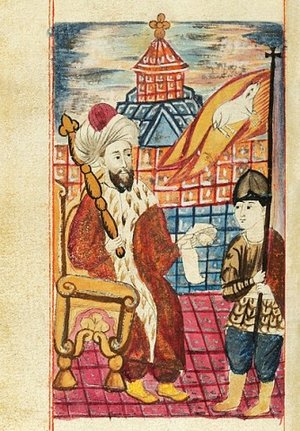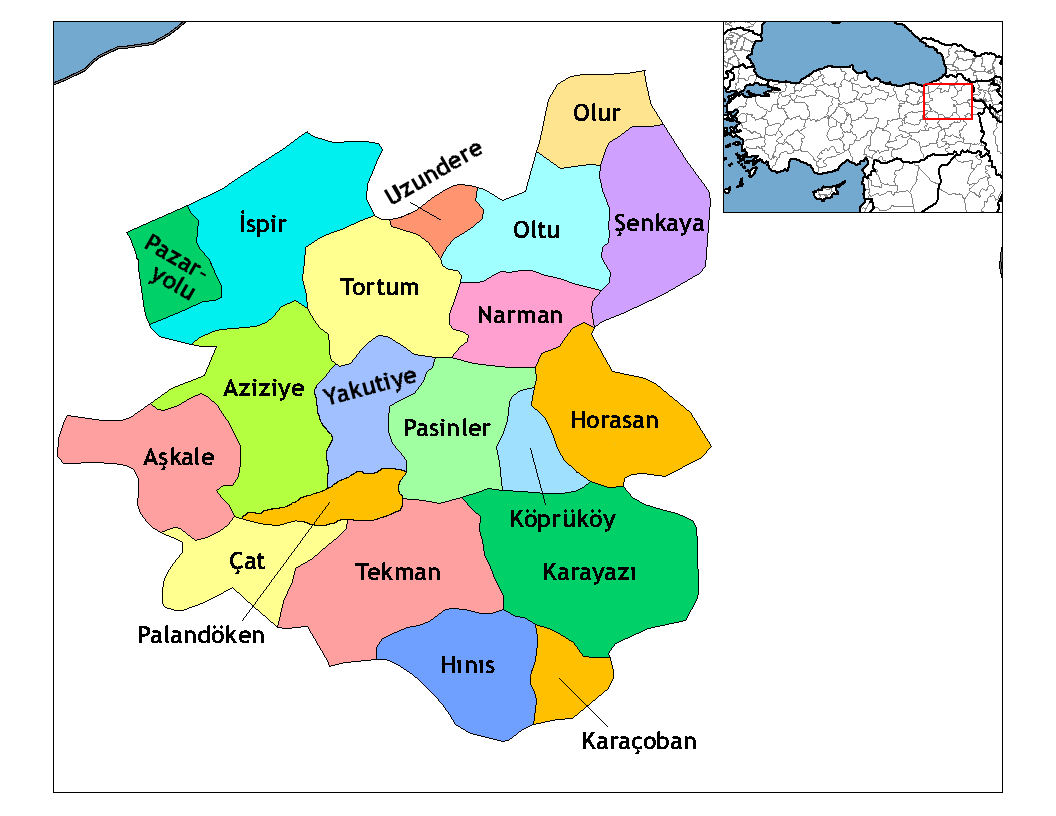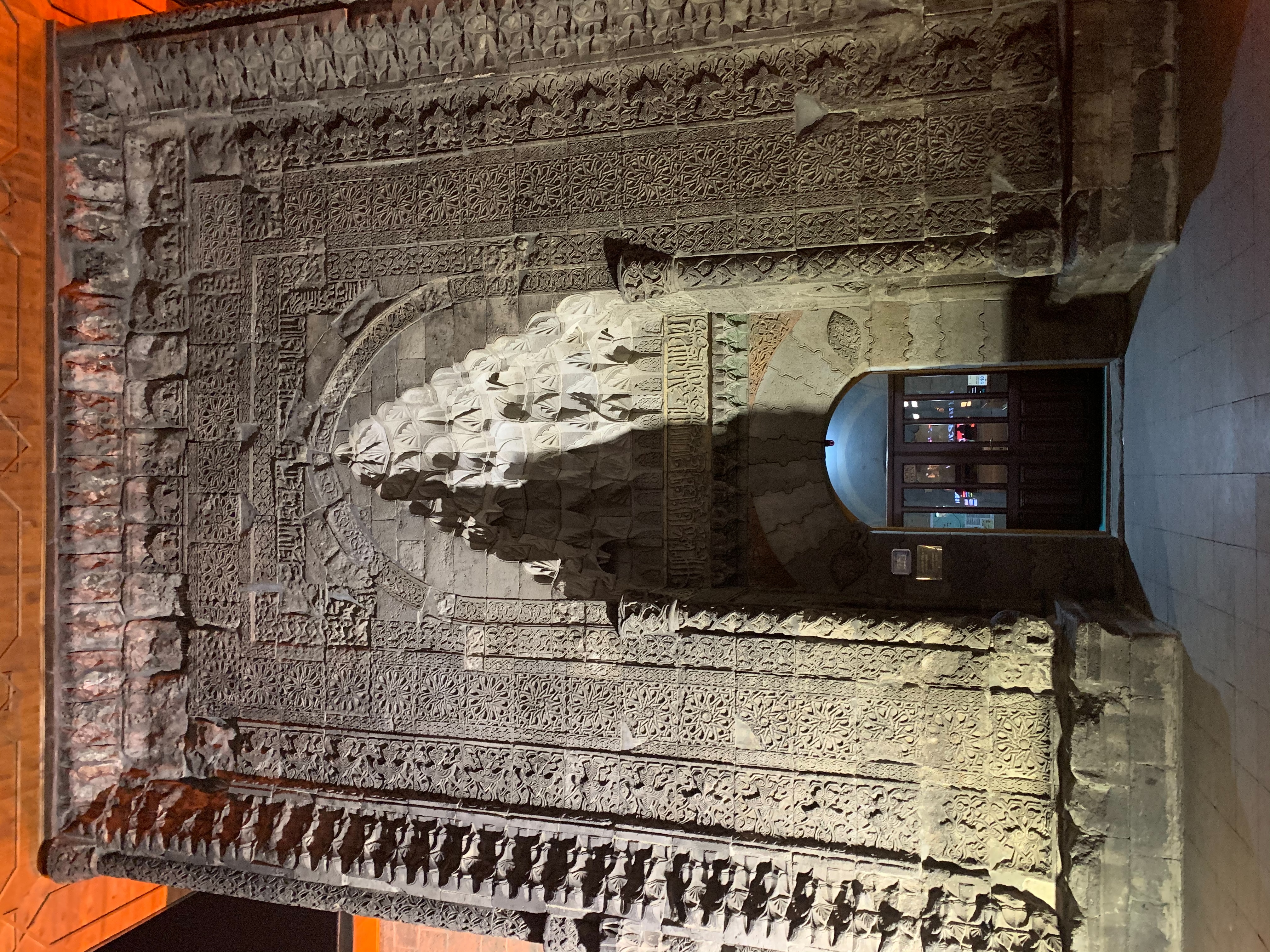|
Ăobandede Bridge
Ăobandede Bridge (, also called Ăoban Bridge) is a historical bridge in Erzurum Province of Turkey. Location The bridge is at to the east of KöprĂŒköy ilçe (district) of Erzurum Province. KöprĂŒköy, literally "bridge Ville" is named after the bridge. The bridge is situated at the point where two tributaries of the Aras River meet. It is on the road from Erzurum to MuĆ. Currently, Ăobandede Bridge is out of service and the Turkish state highway is over a parallel bridge about east of Ăobandede Bridge. History In 1865 a priest, Archimandrite Timeteos, copied an inscription, in Armenian that was on the bridge. It read "this bridge, founded by the Armenians, was repaired by the Magistros under the auspices of the monastery of Sourb Astvatzatzin and the castle of Darun in the year 609" (609 is equivalent to the year 1160). In 1904, Kajberuny saw this inscription, and two others in Arabic, saying that they were located above the arches on the eastern side of the bridge. Neit ... [...More Info...] [...Related Items...] OR: [Wikipedia] [Google] [Baidu] |
Aras River
The Aras is a transboundary river in the Caucasus. It rises in eastern Turkey and flows along the borders between Turkey and Armenia, between Turkey and the Nakhchivan exclave of Azerbaijan, between Iran and both Azerbaijan and Armenia, and, finally, through Azerbaijan where it flows into the Kura river as a right tributary. It drains the south side of the Lesser Caucasus Mountains, while the Kura drains the north side of the Lesser Caucasus. The river's total length is and its watershed covers an area of . The Aras is one of the longest rivers in the Caucasus. Names In classical antiquity, the river was known to the Greeks as Araxes (). Its modern Armenian name is ''Arax'' or ''Araks'' (). Historically, it was called (, in modern pronunciation) by Armenians and its Old Georgian name is ''Rakhsi'' (). In Azerbaijani, the river's name is ''Araz''. In Persian, Kurdish and Turkish its name is (''Aras''). Geography The Aras is supported by the KocagĂŒn stream, Dallı s ... [...More Info...] [...Related Items...] OR: [Wikipedia] [Google] [Baidu] |
Pasinler, Erzurum
Pasinler or Basean (; ; ka, áááĄáááá, tr; ; ; formerly Hasankale and Hesenqele 'the fortress of Hasan'), is a municipality and district of Erzurum Province, Turkey. Its area is 1,134 km2, and its population is 27,055 (2022). It lies on the Aras River. It is located east of the city of Erzurum and is the site of Hasankale Castle (sometimes called Pasinler Castle). It was the birthplace of the Ottoman poet Nef'i. The old name "Hasankale" may be based upon the Aq Qoyunlu ruler Uzun Hasan or upon Hasan the governor of the region in the 1330s or after KĂŒĂ§ĂŒk Hasan, grandson of Coban, who attacked the town in 1340. History The first ancient kingdom that had a control of this territory was Urartu, when it was called Biani. One of the versions of the name Pasinler - it is derived from the ancient tribe called Phasians (Phazians). The name of this tribe seems to have survived in latter-day regional toponyms â Armenian ''Passen'', Greek ''Phasiane'', Georgian ''Ba ... [...More Info...] [...Related Items...] OR: [Wikipedia] [Google] [Baidu] |
Arch Bridges In Turkey
An arch is a curved vertical structure spanning an open space underneath it. Arches may support the load above them, or they may perform a purely decorative role. As a decorative element, the arch dates back to the 4th millennium BC, but structural load-bearing arches became popular only after their adoption by the Ancient Romans in the 4th century BC. Arch-like structures can be horizontal, like an arch dam that withstands the horizontal hydrostatic pressure load. Arches are usually used as supports for many types of vaults, with the barrel vault in particular being a continuous arch. Extensive use of arches and vaults characterizes an arcuated construction, as opposed to the trabeated system, where, like in the architectures of ancient Greece, China, and Japan (as well as the modern steel-framed technique), posts and beams dominate. Arches had several advantages over the lintel, especially in the masonry construction: with the same amount of material it can have larger ... [...More Info...] [...Related Items...] OR: [Wikipedia] [Google] [Baidu] |
Turkish Army
The Turkish Land Forces () is the main branch of the Turkish Armed Forces responsible for Army, land-based military operations. The army was formed on November 8, 1920, after the collapse of the Ottoman Empire. Significant campaigns since the foundation of the army include suppression of rebellions in Southeastern Anatolia region, Southeast Anatolia and Eastern Anatolia region, East Anatolia from the 1920s to the present day, combat in the Korean War, the 1974 Turkish invasion of Cyprus and the current Turkish involvement in the Syrian civil war, as well as its NATO alliance against the USSR during the Cold War. The army holds the preeminent place within the armed forces. It is customary for the List of Chiefs of the Turkish General Staff, Chief of the General Staff of the Turkish Armed Forces to have been the List of commanders of the Turkish Land Forces, Commander of the Turkish Land Forces prior to his appointment as Turkey's senior ranking officer. Alongside the other two a ... [...More Info...] [...Related Items...] OR: [Wikipedia] [Google] [Baidu] |
Ilkhanid
The Ilkhanate or Il-khanate was a Mongol khanate founded in the southwestern territories of the Mongol Empire. It was ruled by the Il-Khans or Ilkhanids (), and known to the Mongols as ''HĂŒlegĂŒ Ulus'' (). The Ilkhanid realm was officially known as the Land of Iran or simply Iran. It was established after Hulegu Khan, HĂŒlegĂŒ, the son of Tolui and grandson of Genghis Khan, inherited the West Asian and Central Asian part of the Mongol Empire after his brother Möngke Khan died in 1259. The Ilkhanate's core territory was situated in what is now the countries of Iran, Azerbaijan, and Turkey. At its greatest extent, the Ilkhanate also included parts of modern Iraq, Syria, Armenia, Georgia (country), Georgia, Afghanistan, Turkmenistan, Pakistan, part of modern Dagestan, and part of modern Tajikistan. Later Ilkhanid rulers, beginning with Ghazan in 1295, converted to Islam. In the 1330s, the Ilkhanate was ravaged by the Black Death. The last ilkhan, Abu Sa'id Bahadur Khan, died in 133 ... [...More Info...] [...Related Items...] OR: [Wikipedia] [Google] [Baidu] |
Anatolia
Anatolia (), also known as Asia Minor, is a peninsula in West Asia that makes up the majority of the land area of Turkey. It is the westernmost protrusion of Asia and is geographically bounded by the Mediterranean Sea to the south, the Aegean Sea to the west, the Turkish Straits to the northwest, and the Black Sea to the north. The eastern and southeastern limits have been expanded either to the entirety of Asiatic Turkey or to an imprecise line from the Black Sea to the Gulf of Alexandretta. Topographically, the Sea of Marmara connects the Black Sea with the Aegean Sea through the Bosporus and the Dardanelles, and separates Anatolia from Thrace in Southeast Europe. During the Neolithic, Anatolia was an early centre for the development of farming after it originated in the adjacent Fertile Crescent. Beginning around 9,000 years ago, there was a major migration of Anatolian Neolithic Farmers into Neolithic Europe, Europe, with their descendants coming to dominate the continent a ... [...More Info...] [...Related Items...] OR: [Wikipedia] [Google] [Baidu] |
Mongol Empire
The Mongol Empire was the List of largest empires, largest contiguous empire in human history, history. Originating in present-day Mongolia in East Asia, the Mongol Empire at its height stretched from the Sea of Japan to parts of Eastern Europe, extending northward into parts of the Arctic; eastward and southward into parts of the Indian subcontinent, mounting invasions of Southeast Asia, and conquering the Iranian plateau; and reaching westward as far as the Levant and the Carpathian Mountains. The Mongol Empire emerged from the unification of several nomad, nomadic tribes in the Mongol heartland under the leadership of TemĂŒjin, known by the title of Genghis Khan (â1227), whom a council proclaimed as the ruler of all Mongols in 1206. The empire grew rapidly under his rule and that of his descendants, who sent out Mongol invasions, invading armies in every direction. The vast transcontinental empire connected the Eastern world, East with the Western world, West, and the Pac ... [...More Info...] [...Related Items...] OR: [Wikipedia] [Google] [Baidu] |
Grigor Magistros
Grigor Magistros (; "Gregory the ''magistros''"; ca. 990–1058) was an Armenians, Armenian prince, Linguistics, linguist, scholar and public functionary. A layman of the princely Pahlavuni family that claimed descent from the dynasty established by St. Gregory the Illuminator, he was the son of the military commander Vasak Pahlavuni. After the Byzantine Empire annexed the Ani, Kingdom of Ani, Gregory went on to serve as the governor (''dux, doux'') of the province of Edessa, Mesopotamia, Edessa. During his tenure he worked actively to suppress the Tondrakians, a breakaway Christian Armenian sect that the Armenian and Byzantine Churches both labeled heresy, heretics. He studied both ecclesiastical and secular literature, Syriac as well as Greek. He collected all Armenian manuscripts of scientific or philosophical value that were to be found, including the works of Anania Shirakatsi, and translations from Callimachus, Andronicus of Rhodes and Olympiodorus of Thebes, Olympiodorus ... [...More Info...] [...Related Items...] OR: [Wikipedia] [Google] [Baidu] |
Erzurum Province
Erzurum Province () is a province and metropolitan municipality in the Eastern Anatolia Region of Turkey. Its area is 25,006 km2, and its population is 749,754 (2022). The capital of the province is the city of Erzurum. It is the fourth largest province in all of Turkey. It is bordered by the provinces of Kars and AÄrı to the east, MuĆ and Bingöl to the south, Erzincan and Bayburt to the west, Rize and Artvin to the north and Ardahan to the northeast. The governor of the province is Mustafa Ăiftçi, appointed in August 2023. The province has a Turkish majority. Geography The surface area of the province of Erzurum is the fourth biggest in Turkey. The majority of the province is elevated. Most plateaus are about above sea level, and the mountainous regions beyond the plateaus are and higher. Depression plains are located between the mountains and plateaus. The southern mountain ranges include the Palandöken Mountains (highest peak BĂŒyĂŒk Ejder high) and t ... [...More Info...] [...Related Items...] OR: [Wikipedia] [Google] [Baidu] |
MuĆ
MuĆ (; ; ) is a city in eastern Turkey. It is the seat of MuĆ Province and MuĆ District.Ä°l Belediyesi Turkey Civil Administration Departments Inventory. Retrieved 22 May 2023. Its population is 120,699 (2022). The city is majority Kurds, Kurdish. Etymology Various explanations of the origin of MuĆ's name exist. Its name is sometimes associated with the Armenian language, Armenian word , meaning fog, explained by the fact that the town and the surrounding plain are frequently covered in fog in the mornings. The 17th-century explorer Evliya Ăelebi relates a myth where a giant mouse created by Nemrud (Nimrod) destroys the city and its inhabitants, after which the city was named MuĆ ( means ...[...More Info...] [...Related Items...] OR: [Wikipedia] [Google] [Baidu] |
Erzurum
Erzurum (; ) is a List of cities in Turkey, city in eastern Anatolia, Turkey. It is the largest city and capital of Erzurum Province and is 1,900 meters (6,233 feet) above sea level. Erzurum had a population of 367,250 in 2010. It is the site of ancient Theodosiopolis. The city uses the double-headed eagle as its coat-of-arms, a motif that has been a common symbol throughout Anatolia since the Bronze Age. Erzurum has winter sports facilities, hosted the 2011 Winter Universiade, and the 2023 Winter Deaflympics (in March 2024). Name and etymology The city was originally known in Armenian language, Armenian as Karno K'aghak' (), meaning city of Karin, to distinguish it from the district of Karin (wikt:ÔżŐĄÖŐ«Ő¶, ÔżŐĄÖŐ«Ő¶). It is presumed its name was derived from a local tribe called the Karenitis. Darbinian, M. "Erzurum," Armenian Soviet Encyclopedia. Yerevan: Armenian Academy of Sciences, 1978, vol. 4, p. 93. An alternate theory contends that a local princely family, the Kams ... [...More Info...] [...Related Items...] OR: [Wikipedia] [Google] [Baidu] |







